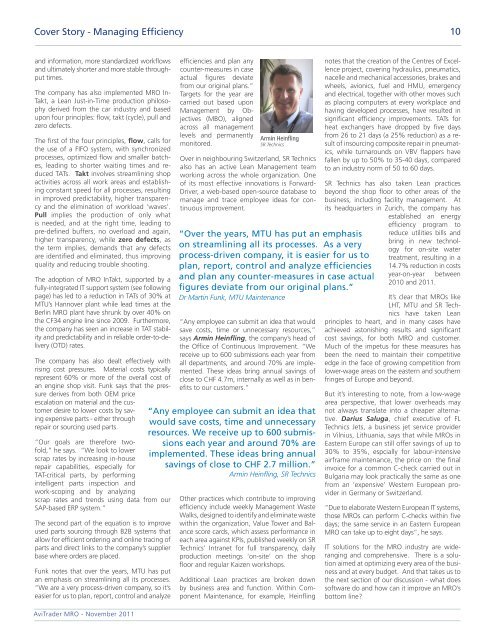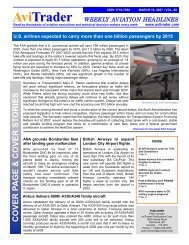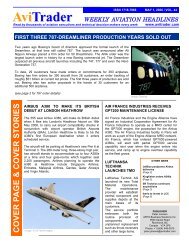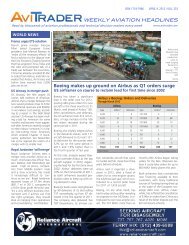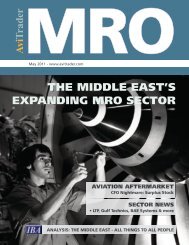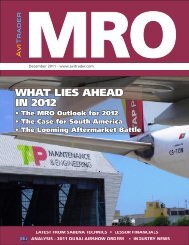MRO - AviTrader
MRO - AviTrader
MRO - AviTrader
You also want an ePaper? Increase the reach of your titles
YUMPU automatically turns print PDFs into web optimized ePapers that Google loves.
Cover Story - Managing Efficiency<br />
and information, more standardized workflows<br />
and ultimately shorter and more stable throughput<br />
times.<br />
The company has also implemented <strong>MRO</strong> In-<br />
Takt, a Lean Just-in-Time production philosophy<br />
derived from the car industry and based<br />
upon four principles: flow, takt (cycle), pull and<br />
zero defects.<br />
The first of the four principles, flow, calls for<br />
the use of a FIFO system, with synchronized<br />
processes, optimized flow and smaller batches,<br />
leading to shorter waiting times and reduced<br />
TATs. takt involves streamlining shop<br />
activities across all work areas and establishing<br />
constant speed for all processes, resulting<br />
in improved predictability, higher transparency<br />
and the elimination of workload ‘waves’.<br />
pull implies the production of only what<br />
is needed, and at the right time, leading to<br />
pre-defined buffers, no overload and again,<br />
higher transparency, while zero defects, as<br />
the term implies, demands that any defects<br />
are identified and eliminated, thus improving<br />
quality and reducing trouble shooting.<br />
The adoption of <strong>MRO</strong> InTakt, supported by a<br />
fully-integrated IT support system (see following<br />
page) has led to a reduction in TATs of 30% at<br />
MTu’s hannover plant while lead times at the<br />
Berlin <strong>MRO</strong> plant have shrunk by over 40% on<br />
the CF34 engine line since 2009. Furthermore,<br />
the company has seen an increase in TAT stability<br />
and predictability and in reliable order-to-delivery<br />
(OTD) rates.<br />
The company has also dealt effectively with<br />
rising cost pressures. Material costs typically<br />
represent 60% or more of the overall cost of<br />
an engine shop visit. Funk says that the pressure<br />
derives from both OEM price<br />
escalation on material and the cus-<br />
tomer desire to lower costs by saving<br />
expensive parts - either through<br />
repair or sourcing used parts.<br />
“Our goals are therefore twofold,”<br />
he says. “We look to lower<br />
scrap rates by increasing in-house<br />
repair capabilities, especially for<br />
TAT-critical parts, by performing<br />
intelligent parts inspection and<br />
work-scoping and by analyzing<br />
scrap rates and trends using data from our<br />
SAP-based ERP system.”<br />
The second part of the equation is to improve<br />
used parts sourcing through B2B systems that<br />
allow for efficient ordering and online tracing of<br />
parts and direct links to the company’s supplier<br />
base where orders are placed.<br />
Funk notes that over the years, MTu has put<br />
an emphasis on streamlining all its processes.<br />
“We are a very process-driven company, so it’s<br />
easier for us to plan, report, control and analyze<br />
<strong>AviTrader</strong> <strong>MRO</strong> - November 2011<br />
efficiencies and plan any<br />
counter-measures in case<br />
actual figures deviate<br />
from our original plans.”<br />
Targets for the year are<br />
carried out based upon<br />
Management by Objectives<br />
(MBO), aligned<br />
across all management<br />
levels and permanently<br />
monitored.<br />
Armin Heinfling<br />
SR Technics<br />
Over in neighbouring Switzerland, SR Technics<br />
also has an active Lean Management team<br />
working across the whole organization. One<br />
of its most effective innovations is Forward-<br />
Driver, a web-based open-source database to<br />
manage and trace employee ideas for continuous<br />
improvement.<br />
“Over the years, MTU has put an emphasis<br />
on streamlining all its processes. As a very<br />
process-driven company, it is easier for us to<br />
plan, report, control and analyze efficiencies<br />
and plan any counter-measures in case actual<br />
figures deviate from our original plans.”<br />
Dr Martin Funk, MTU Maintenance<br />
“Any employee can submit an idea that would<br />
save costs, time or unnecessary resources,”<br />
says Armin Heinfling, the company’s head of<br />
the Office of Continuous Improvement. “We<br />
receive up to 600 submissions each year from<br />
all departments, and around 70% are implemented.<br />
These ideas bring annual savings of<br />
close to CHF 4.7m, internally as well as in benefits<br />
to our customers.”<br />
“Any employee can submit an idea that<br />
would save costs, time and unnecessary<br />
resources. We receive up to 600 submissions<br />
each year and around 70% are<br />
implemented. These ideas bring annual<br />
savings of close to CHF 2.7 million.”<br />
Armin Heinfling, SR Technics<br />
Other practices which contribute to improving<br />
efficiency include weekly Management Waste<br />
Walks, designed to identify and eliminate waste<br />
within the organization, Value Tower and Balance<br />
score cards, which assess performance in<br />
each area against KPIs, published weekly on SR<br />
Technics’ Intranet for full transparency, daily<br />
production meetings ‘on-site’ on the shop<br />
floor and regular Kaizen workshops.<br />
Additional Lean practices are broken down<br />
by business area and function. Within Component<br />
Maintenance, for example, heinfling<br />
10<br />
notes that the creation of the Centres of Excellence<br />
project, covering hydraulics, pneumatics,<br />
nacelle and mechanical accessories, brakes and<br />
wheels, avionics, fuel and hMu, emergency<br />
and electrical, together with other moves such<br />
as placing computers at every workplace and<br />
having developed processes, have resulted in<br />
significant efficiency improvements. TATs for<br />
heat exchangers have dropped by five days<br />
from 26 to 21 days (a 25% reduction) as a result<br />
of insourcing composite repair in pneumatics,<br />
while turnarounds on VBV flappers have<br />
fallen by up to 50% to 35-40 days, compared<br />
to an industry norm of 50 to 60 days.<br />
SR Technics has also taken Lean practices<br />
beyond the shop floor to other areas of the<br />
business, including facility management. At<br />
its headquarters in Zurich, the company has<br />
established an energy<br />
efficiency program to<br />
reduce utilities bills and<br />
bring in new technology<br />
for on-site water<br />
treatment, resulting in a<br />
14.7% reduction in costs<br />
year-on-year between<br />
2010 and 2011.<br />
It’s clear that <strong>MRO</strong>s like<br />
LhT, MTu and SR Technics<br />
have taken Lean<br />
principles to heart, and in many cases have<br />
achieved astonishing results and significant<br />
cost savings, for both <strong>MRO</strong> and customer.<br />
Much of the impetus for these measures has<br />
been the need to maintain their competitive<br />
edge in the face of growing competition from<br />
lower-wage areas on the eastern and southern<br />
fringes of Europe and beyond.<br />
But it’s interesting to note, from a low-wage<br />
area perspective, that lower overheads may<br />
not always translate into a cheaper alternative.<br />
Darius Saluga, chief executive of FL<br />
Technics Jets, a business jet service provider<br />
in Vilnius, Lithuania, says that while <strong>MRO</strong>s in<br />
Eastern Europe can still offer savings of up to<br />
30% to 35%, espcially for labour-intensive<br />
airframe maintenance, the price on the final<br />
invoice for a common C-check carried out in<br />
Bulgaria may look practically the same as one<br />
from an ‘expensive’ Western European provider<br />
in Germany or Switzerland.<br />
“Due to elaborate Western European IT systems,<br />
those <strong>MRO</strong>s can perform C-checks within five<br />
days; the same service in an Eastern European<br />
<strong>MRO</strong> can take up to eight days”, he says.<br />
IT solutions for the <strong>MRO</strong> industry are wideranging<br />
and comprehensive. There is a solution<br />
aimed at optimizing every area of the business<br />
and at every budget. And that takes us to<br />
the next section of our discussion - what does<br />
software do and how can it improve an <strong>MRO</strong>’s<br />
bottom line?


